I
I-beam principle See: Moment of inertia.
ICTP Abbreviation for C-terminal telopeptide of type I collagen. See: C-telopeptide pyridinoline cross-links of type I collagen.
IGF Abbreviation for Insulin-like growth factor.
IIL Abbreviation for Interleukin.
Iliac bone See: Ilium.
Iliac crest Long, curved superior border of the ilium. Serves as a donor site for most preferred autogenous grafts for larger augmentation procedures.1 See also: Iliac crest graft; Ilium.
Iliac crest graft Common extraoral corticocancellous autogenous bone graft used in cases where large block volumes for alveolar ridge reconstruction are required. See also: Alveolar ridge augmentation; Iliac bone grafting for.
Ilium The largest and uppermost portion of hip bone. The hip bone is the broadest bone of the skeleton, located in the sidewall and anterior wall of the pelvis. It is made up of three bones or parts: the ilium, ischium, and pubis.
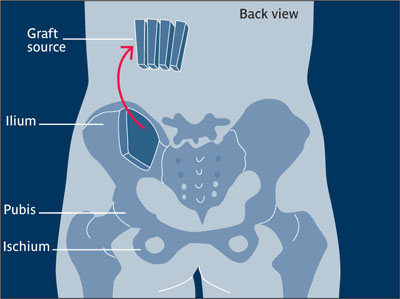
Ilium.
Image guidance General technique of using preoperative diagnostic imaging with computer-based planning tools to facilitate surgical and restorative plans and procedures.2-4
Imaging guide Scan to determine bone volume, inclination and shape of the alveolar process, and bone height and width, which is used at surgical site. See also: Computed tomography (CT) scan; Three-dimensional guidance system for implant placement; Backscattered electron (BSE) imaging.
Immediate functional loading Implant prosthesis is seated at the time of implant placement and immediately subjected to functional loading. See also: Functional loading.
Immediate implant placement Implant placement immediately following extraction of a tooth. This procedure must be combined in most patients with a bone-grafting technique to eliminate peri-implant bone defects.
Immediate loading Application of functional or nonfunctional load to an implant at the time of surgical placement or shortly thereafter; generally considered to be loading within 48 hours of implant placement.5 See also: Immediate functional loading; Immediate nonfunctional loading.
Orthodontics and i. l. Loading of temporary orthodontic implants immediately after placement, without an intervening period of unloaded healing. See also: Orthodontic anchorage implant.
Tooth extraction and i. l. Implant placed and put into function at the time the natural tooth is extracted.
Immediate nonfunctional loading Implant prosthesis is seated at the time of implant placement but kept out of direct occlusal contact. Loading occurs from lip and tongue pressure and contact with food, but not from contact with the opposing teeth.
Immediate provisionalization Fabrication and seating of provisional restoration at time of implant placement. The provisional restoration may or may not be designed for immediate functional occlusal contact.6
Immediate restoration Dental prosthesis placed immediately following the removal of a natural tooth or teeth.7,8 See: Immediate provisionalization.
Immunity Condition of being immune; all mechanisms used by the body as protection against foreign environmental agents. See also: Acquired immunity; Innate immunity.
Immunocompetence Ability or capacity to develop a normal immune response following exposure to antigen.
Immunoglobulin Glycoprotein composed of heavy and light peptide chains; functions as antibody in serum and secretions. There are five major classes (IgG, IgA, IgM, IgE, and IgD) on the basis of structure and biologic activity.
Immunologic response Bodily defense in reaction to an invading substance (antigen, such as virus, fungus, bacteria, or transplanted organ) that produces a response, including antibody production, cell-mediated immunity, or immunologic tolerance.
Impaction of tooth Developmental disturbance in which a tooth does not fully erupt into occlusion. It may be a tooth bud or fully developed tooth surrounded by bone, either partially or fully. The most frequently impacted teeth are mandibular third molars.
Implant Biocompatible alloplastic device, tissue, or substance surgically placed into recipient for the improvement of an existing condition. Generally placed for restorative purposes but may also be used with diagnostic or experimental intentions.7,9 See also: Angled/angulated implant; Blade implant; Complete subperiosteal implant; Craniofacial implant; Cylindrical implant; Disk implant; Distraction implant; Endosseous implant; Endosseous ramus implant; Eposteal implant; Free-standing implant; Malpositioned implant; Mini-implant; Nonsubmerged implant; Nonthreaded implant; Ocular implant; One-piece implant; Percutaneous implant; Provisional implant; Ramus frame implant; Root-form implant; Skin-penetrating implant; Sleeper implant; Tapered implant; Threaded implant; Transosseous implant; Two-piece implant; Zygomatic implant.
Implant abutment See: Abutment; Angled/ angulated abutment; CAD/CAM abutment; Ceramic abutment; Castable abutment; Nonangled abutment; Nonrotating abutment; Transmucosal abutment.
Implant-abutment interface Surface forming a common boundary between the abutment and implant.10 See also: Microgap.
Implant anchorage Use of endosseous implant for anchorage during tooth movement in orthodontic treatment. Used to provide resistance to unwanted natural tooth movement. Also, use of implants in orthodontic treatment to provide anchorage for prosthesis.11
Implant axis Axis through the body of an implant dictated by its greatest dimension.
Implant basket Design feature of an implant that has a hollow apical portion, which allows a core of bone to remain in the preparation of the osteotomy site and fit within the confines of the hollow apical portion. Called also inverted basket or hollow cylinder.12,13

Implant basket.
Implant body Anchorage component embedded in tissue, usually bone, by which all other components in an implant system are supported. Other components are stacked or threaded one into another.14
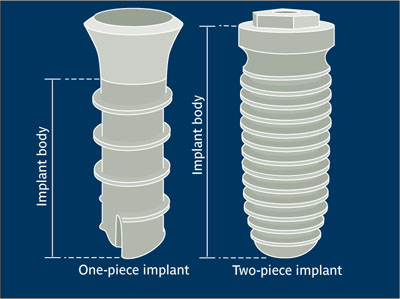
Implant body.
Implant-bone interface When bone substitutes are applied, newly formed host bone creates an interface between the implant surface and alveolar bone as the implant becomes osseointegrated.
Implant collar Most coronal portion of an implant or anchorage component. The collar can have the same surface finish as the remaining portion of the implant anchorage component or have a different surface finish designed by a manufacturer.
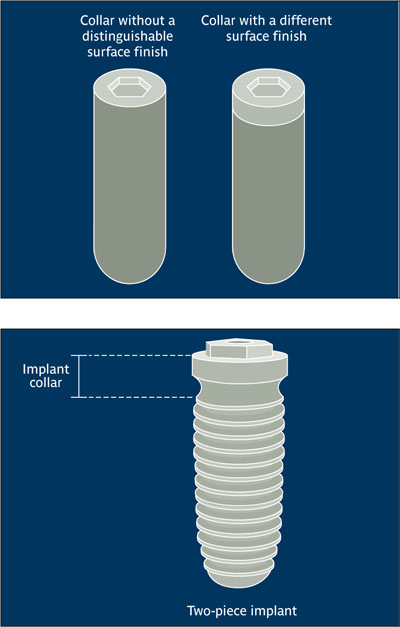
Implant collar.
Implant component “One of the principal portions of an implant system or one of the structural sections of a dental implant abutment.”15,16
Implant configuration Pattern or arrangement of the positions of two or more implants placed intraorally.
Implant-crown ratio See: Crown-implant ratio.
Implant dentistry Field of dental art and science concerned with diagnosis and treatment planning for implant-supported restorations, surgical placement of implants, and the restorative treatment and subsequent maintenance procedures.6,7
Implant design Conceptualization of an implant form at the planning or designing stage as carried through production.
Implant diameter Length of the horizontal axis through the center of an implant body. Anchorage components (implants) are available in various diameters and lengths, and the dimensions vary among the various implant manufacturers. The symbol used to reflect the diameter is Ø.
Implant exposure Postoperative condition in which an implant is not completely covered by soft tissues because of wound dehiscence. A second surgical procedure following implant placement is used to access the implant shoulder, remove the healing screw, and replace it with an abutment. This can be accomplished with a punch technique or flap elevation.
Implant head Most coronal part or area of an implant. The same area, ie the coronal surface, can be referred to as the platform.
Implant insertion See: Implant placement.
Implant installation See: Implant placement.
Implant interface Contacting surface of living tissue (bone) and nonliving alloplast (implant).6,7 See also: Osseointegration.

Implant interface (arrows).
(Redrawn from Brånemark et al17 with permission.)
Implant length Straight-line dimension of the vertical axis of an implant body. Anchorage components (implants) available in various diameters and lengths. Dimensions vary for specific applications among the various implant manufacturers.
Implant-level impression To record an implant platform at the tissue level, a coping is attached to the implant and an impression is made for laboratory restorative procedures. The resultant cast usually contains an elastomeric material at the implant site.6
Implant loading Act of placing forces on an implant through function and/or parafunction. See also: Delayed loading; Dynamic loading; Early loading; Immediate functional loading; Immediate nonfunctional loading; Static loading.
Alveolar bone growth and i. l. Phenomenon observed beneath mandibular cantilever prostheses. Considered to be an example of Wolff Law of bone loading.18
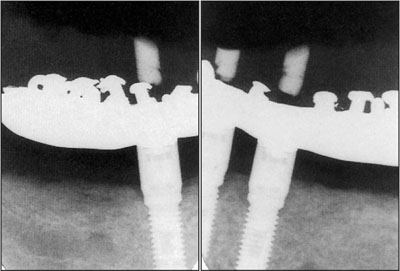
Alveolar bone growth and implant loading (prosthesis placement).
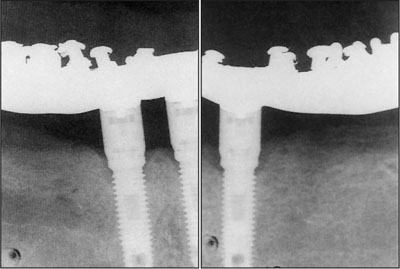
Alveolar bone growth and implant loading (2 years, 8 months; increase in crestal bone height: 3mm).
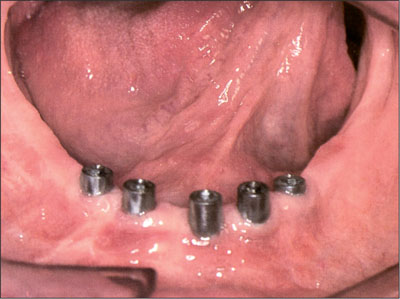
Alveolar bone growth and implant loading (2 years, 8 months; osseous proliferation).
(Reprinted from Taylor18 with permission.)
Implant loss Circumstances whereby the implant is removed from the patient. See also: Early implant loss; Late implant loss.
Implant material See: Commercially pure titanium (CPTi); Hydroxyapatite (HA); Titanium alloy; Zirconium oxide.
Implant micromotion, effects of See: Micromotion.
Implant micromovement Relative motion between an implant body and its investing tissues at the microscopic level; not clinically visible.
Implant mobility Relative motion between an implant body and its investing tissues.
Implant mount Component positioned onto the implant facilitating surgical placement of the implant into the osteotomy site. May be removed by loosening the attachment mechanism to the implant, either through removal of a screw or release of a frictional fit into the implant.14,19
Implant neck Coronal portion of the implant in which a constriction in diameter width may or may not be present below the platform area.20 See also: Cervix; Implant collar.
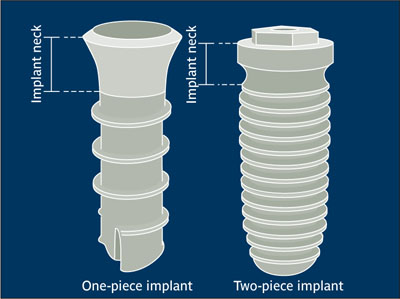
Implant neck.
Implant osseointegration See: Osseointegration.
Stay updated, free dental videos. Join our Telegram channel

VIDEdental - Online dental courses


